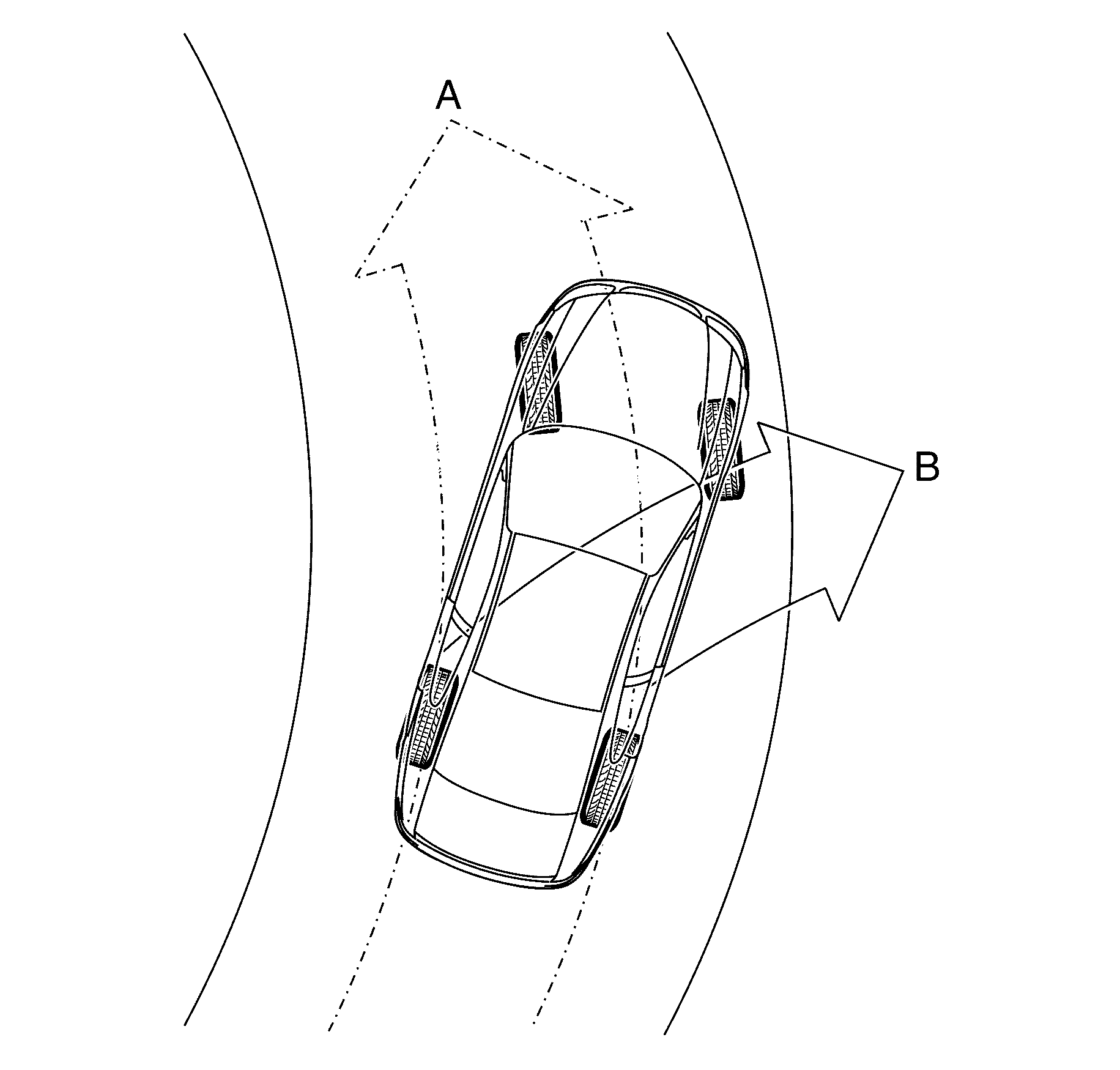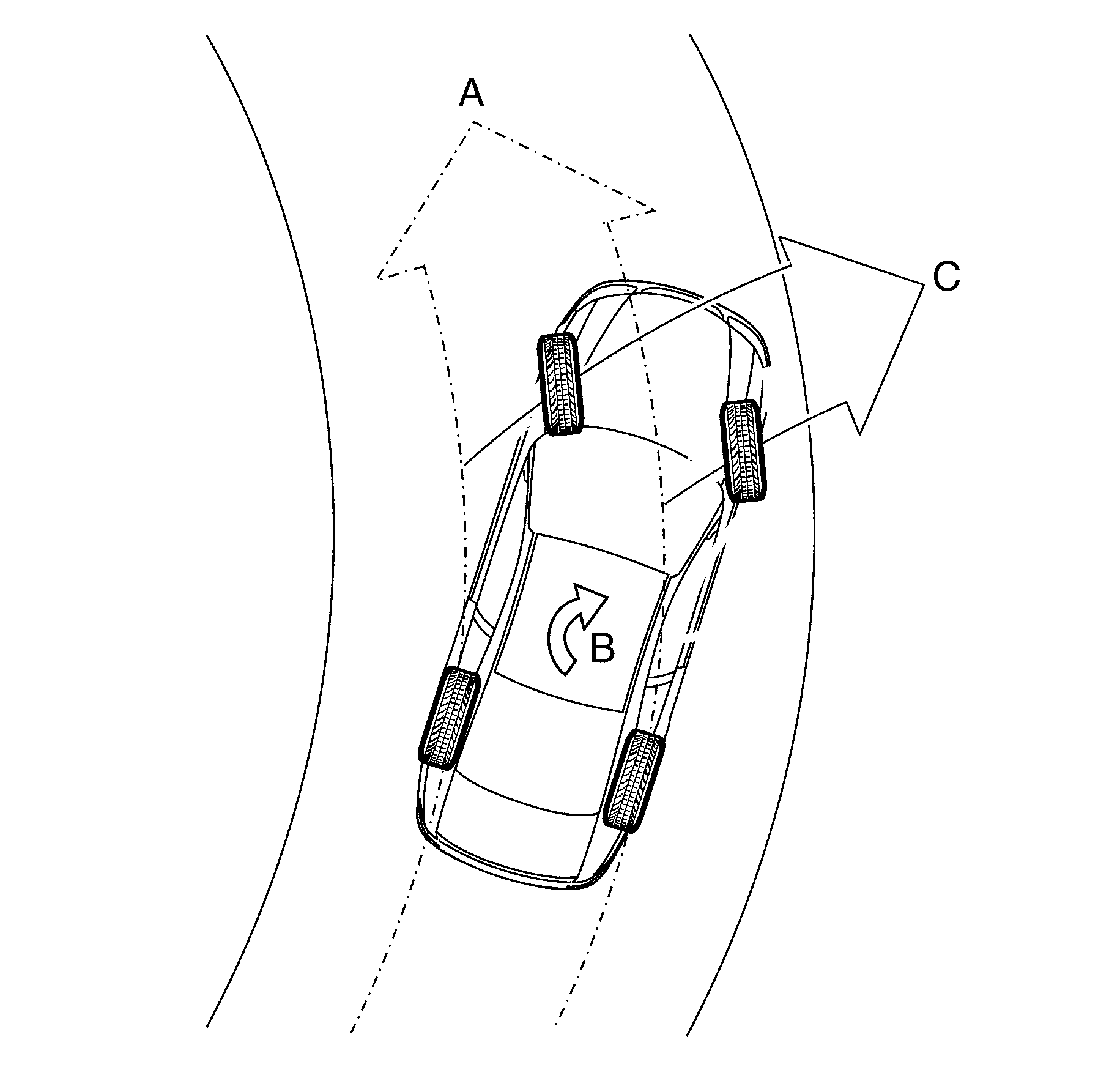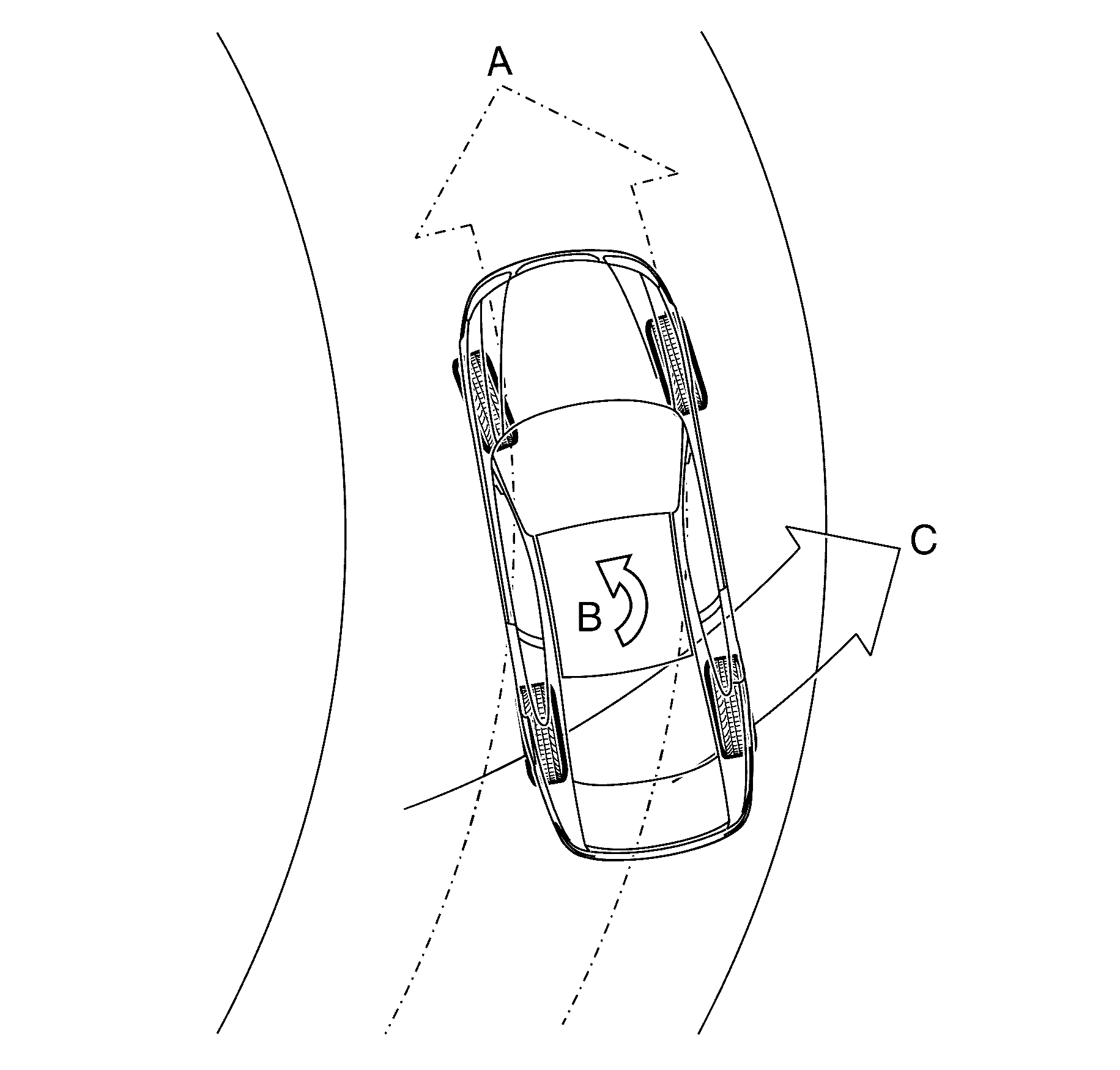The brake pressure modulator valve (BPMV) assembly (1) modulates the
brake fluid pressure (A) based on the control signal sent by the electronic
brake control module (EBCM).
To allow individual control of each wheel brake fluid circuit, a four-channel
circuit configuration with a front/rear split is used. Each of the brake fluid circuits
are hydraulically isolated, which enables continued braking ability if a leak develops
in any of the brake fluid circuits. The BPMV components consist of the following:
Active wheel speed sensors are fitted to this vehicle. Active wheel speed sensors
are direction sensitive.
The wheel speed sensor receives a 12-volt power supply voltage from the electronic
brake control module (EBCM). The wheel speed sensor contains an integrated circuit
containing a magneto-resistive bridge. Wheel rotation changes the positioning of the
tone wheel and the wheel speed sensor's magnetic field and varies the magneto-resistive
bridge resistance. The wheel speed sensor's integrated circuit modifies and amplifies
the varying resistance into a direct current (DC) square wave signal. Therefore as
the wheel spins, the wheel speed sensor changes the voltage and current level output
signal to the EBCM. The wheel speed sensor always has a current flow on the output
signal circuit to complete the wheel speed sensor's ground path and for EBCM diagnostics.
The EBCM uses the frequency of the square wave signal to calculate the wheel speed.
The brake pedal position sensor (1) is a normally open switch that closes
when the brake pedal is depressed.
The electronic brake control module (EBCM) uses the stop lamp switch signal
voltage to determine when the brake pedal is depressed.
The ESP switch incorporates traction control (TCS) which is part of a multi
function centre console switch assembly and is located in the console as shown above.
The ESP switch is a momentary contact switch that sends a ground output signal
to the body control module (BCM).
The BCM sends a signal to the EBCM via the serial data bus to perform the following
functions:
If there are no current TCS/ESP DTC's logged, the ESP activates at the next
ignition cycle.
The yaw-rate sensor assembly (1) comprises of a yaw-rate sensor and a
lateral acceleration sensor.
The EBCM uses the output signal voltage of the yaw-rate sensor and the acceleration
sensor in conjunction with the wheel speed sensor signal output voltage and serial
data output signal of the steering angle sensor, to support the calculation of actual
vehicle behavior as compared to the driver intended direction.
When the vehicle is stationary (View A), the distance between the mass plate
and the 2 side plates are equal. Therefore, the capacitance between the 2 capacitors
is the same and the acceleration sensor signal voltage is zero.
As the vehicle accelerates (View B), the side plates move with the vehicle (C)
while the mass plate, which is suspended by springs tends to move in the opposite
direction. Therefore, the distance between the side plates and the mass plates changes
in proportion to the level of acceleration.
This changes the capacitance between the 2 capacitors causing the acceleration
sensor to produce a signal voltage with an amplitude proportional to the movement
of the mass plates.
While in the presence of a magnetic field, electric current is applied to the
oscillating plates, which causes the plates to move at a constant amplitude (W).
When the vehicle is driving in a straight-ahead direction and there are not
lateral forces applied to the acceleration sensors, the distance between the mass
plates (4) and the side plates of the acceleration sensors are equal (5).
Therefore, the capacitance between the capacitors are the same and the acceleration
sensor signal voltage is zero.
When the vehicle rotates around its vertical axis, the following situation occurs.
The evaluation circuit of the yaw-rate sensor compares and evaluates the output
signal of both acceleration sensors to calculate the level of vehicle rotation around
its vertical axis.
The steering angle sensor provides a signal output that represents the steering
wheel degree of rotation. The EBCM uses this information to calculate the driver intended
driving direction. The steering angle sensor contains:
The anisotropic magneto resistive integrated circuit (AMRIC) (1) comprises
of eight AMR elements (2) which are configured to form two Wheatstone bridges (3).
One of the Wheatstone bridges (4) is 45 degrees offset from the
other to enable the AMR IC to produce sine (5) and cosine (6) output
signal.
The AMR elements change resistance that corresponds to the changes in the angle
of magnetic field projected to the AMR IC, regardless of the polarity of the magnetic
field.
The evaluation circuit of the steering angle sensor evaluated and combines the
output signal of the AMR IC to produce two identical linear output (A) that represents
the 360 degrees angular rotation of the magnetic field.
The omni polarity of the AMR elements limits the signal output range of a single
AMR IC from 0-180 degrees.
To increase the output signal range of the steering angle sensor, and enable
it to produce an output signal that can represent the ±760 degrees of
steering wheel rotation, two AMR ICs are fitted to the steering angle sensor.
The magnets (1) that project magnetic fields to the AMR ICs are mounted
on the primary measuring gear (2) and secondary measuring gear (3).
The secondary gear has two less teeth when compared against the primary measuring
gear. This causes the measuring gears to rotate at a different ratio.
The angular orientation of the magnetic fields produced by the measuring gear
magnets (1) corresponds to the degree of steering wheel angular position.
This magnetic field changes the resistance value of the AMR elements, which
enable the AMR ICs (2) to produce a pair of signal outputs (3).
The difference in the rotational ratio between the measuring gears causes the
signal output of the second AMR IC (A) to be shorter in range when compared against
the signal output of the first AMR IC (B).
The evaluation circuit (4) compares and evaluates this difference, and
the rate of change between the output signals of the AMR ICs, at parallel points (5)
to calculate that precise steering wheel angular position.
The antilock braking system (ABS) prevents wheel lock-up during hard or emergency
braking by modulating the brake fluid pressure applied to the appropriate wheels.
The ABS cycles through the following phases when the electronic brake control module
(EBCM) detects the beginning of the wheel lock-up:
The EBCM closes the inlet valve and keeps the outlet valve closed in order to
isolate the system when wheel slip occurs. This maintains the pressure steady on the
brake so that the hydraulic pressure does not increase or decrease.
The EBCM decreases the pressure to individual wheels during a deceleration when
wheel slip occurs. The inlet valve is closed and the outlet valve is opened. The excess
fluid is stored in the accumulator until the return pump can return the fluid to the
master cylinder.
The EBCM increases the pressure to individual wheels during a deceleration in
order to reduce the speed of the wheel. The inlet valve is opened and the outlet valve
is closed. The increased pressure is delivered from the master cylinder.
The electronic brake-force distribution (EBD) system is part of the ABS software
programmed into the electronic brake control module (EBCM). It is designed to replace
the rear brake proportioning valve in reducing rear wheel slip during moderate braking.
The EBD system utilises the existing ABS active controls to regulate the vehicle's
rear brake fluid pressure. This enables the EBD system to provide dynamic front to
rear brake proportioning under various vehicle loads, driving manoeuvres, or road
conditions.
In some situations, when the EBD system is activated, a brake pedal height drop
of approximately 10 mm will be experienced when the driver varies the brake pedal
pressure while performing brake stops. This is caused by the hydraulic modulator performing
an adjustment on the rear brake fluid pressure and is considered normal.
The EBD system plays an important role in vehicle stability during braking.
For this reason, the EBD system has a Keep Alive Function integrated in its software.
When the EBCM detects a fault in the ABS, depending on the type of fault, certain
parts of the system are kept alive. This allows the EBD system to apply some rear
wheel brake proportioning even under certain ABS faults.
The traction control system (TCS) utilises the active braking controls
in the ABS and the engine torque reduction function of the engine management system
to prevent longitudinal wheel spin during vehicle acceleration.
When drive wheel slip is noted while the brake is not applied, the EBCM will
enter traction control mode.
First, the EBCM requests the ECM to reduce the amount of torque to the drive
wheels via the requested torque signal circuit. The ECM reduces torque to the drive
wheels by retarding spark timing and turning off fuel injectors. The ECM reports the
amount torque delivered to the drive wheels via the delivered torque signal circuit.
If the engine torque reduction does not abolish drive wheel slip, the EBCM will
actively apply the drive wheel brakes. During traction control braking, hydraulic
pressure in each drive wheel circuit is controlled to prevent the drive wheels from
slipping. The master cylinder isolation valve closes in order to isolate the master
cylinder from the rest of the hydraulic system. The prime valve then opens in order
to allow the pump to accumulate brake fluid in order to build hydraulic pressure for
braking. The drive wheel inlet and outlet solenoid valves then open and close in order
to perform the following functions:
If at any time during TCS mode the brakes are manually applied, the brake switch
sends a signal to the EBCM to exit the TCS brake intervention mode and allow for manual
braking.
The electronic stability program (ESP) is designed to provide optimum vehicle
stability and steering control during high speed cornering or when driving on a slippery
road surface.
Yaw rate is the rate of rotation about the vehicle's vertical axis. The VSES
is activated when the EBCM determines that the desired yaw rate does not match the
actual yaw rate as measured by the yaw rate sensor.
The difference between the desired yaw rate and the actual yaw rate is the yaw
rate error, which is a measurement of oversteer or understeer. If the yaw rate error
becomes too large, the EBCM attempts to correct the vehicle's yaw motion by applying
differential braking to the appropriate wheel. The amount of differential braking
applied to the left or right front wheel is based on both the yaw rate error and side
slip rate error.
The VSES activations generally occur during aggressive driving, in turns or
on bumpy roads without much use of the accelerator pedal. When braking during VSES
activation, the pedal pulsations feel different than the ABS pedal pulsations. The
brake pedal pulsates at a higher frequency during VSES activation.
When the ESP detects a lateral wheel slip or when the calculated vehicle direction
deviates from the actual vehicle direction, the ESP utilises the engine torque reduction
functionality and the active braking controls in the ABS-TCS to stabilise and steer
the vehicle to the correct direction.
The ESP monitors the wheel speed sensor, yaw-rate sensor and the steering angle
sensor to determine lateral wheel slip. When the ESP detects a lateral wheel slip,
the ESP initially utilises the torque reduction functionality of the TCS and sends
a serial data communication signal to the engine control module (ECM) requesting engine
torque reduction. In addition, if the ESP still detects a lateral wheel slip, the
ESP applies active brake intervention.
The ESP applies active brake intervention when the EBCM receives the following
input signals and determines the vehicle is beginning to understeer.
The ESP uses the existing active braking control in the ABS-TCS to apply a calculated
braking force to one or both inner wheels (1) of the vehicle to stabilise and
steer the vehicle to the intended direction.
The EBCM monitors and compares signals from the yaw-rate sensor, steering angle
sensor and each wheel speed sensor to determine wheel slip. If the EBCM detects the
beginning of a vehicle understeer condition, the EBCM sends the following signal to
the hydraulic modulator to:
The ESP applies active brake intervention when the EBCM receives the following
input signals and determines the vehicle is beginning to oversteer.
The ESP uses the existing active braking control in the ABS-TCS to apply a calculated
braking force to one or both outer wheels (1) of the vehicle to stabilise and
steer the vehicle to the intended direction.
Applying brake-force to the outer wheel (1) slows down the outer side
of the vehicle, which induces the inner wheel to rotate on its vertical axis (A).
The EBCM monitors and compares signals from the yaw-rate sensor, steering angle
sensor and each wheel speed sensor to determine wheel slip. If the EBCM detects the
beginning of a vehicle oversteer condition, the EBCM sends the following signal to
the hydraulic modulator to:
Longitudinal wheel slip is a loss of adhesion between the tyres and the road
surface. This occurs when the vehicle is moving in a straight ahead direction and
the braking or acceleration forces applied to a tyre exceeds the amount of adhesion
available to that tyre.
When none of the wheels are locked during braking, the brakes work by converting
kinetic energy (forward motion of the vehicle) into thermal energy (heat). The friction
between the stationary brake pad and the rotating disc as it slides past the pad convert
the motion of the wheel and tyre into heat. The brake disc is designed to work like
a heat sink, and absorbs as much as 80% of the heat generated during stopping. The
brake disc is cooled as it spins through the air on the way to the next stop. The
friction surfaces between the brake pads and the brake disc are designed to provide
a stable and controlled braking action. Therefore, a vehicle that is braked without
locking the wheel will stop in a shorter distance while maintaining directional stability
and steering capability. Maximum braking efficiency is achieved when a wheel lock
slip is prevented.
Lateral wheel slip is the loss of adhesion between the tyres and the road surface,
which occurs when the vehicle is cornering or when too much engine torque is applied
to the vehicle and the following forces applied to the tyres exceeds the amount of
adhesion available to that tyre:
In addition, steering control depends upon tyre adhesion. A locked wheel in
a 100 percent slip condition delivers poor braking and directional control.
The front tyre direction (A) has minimal steering effect while the vehicle
skids in direction (B). The tyres must regain their adhesion before steering
control is restored to the vehicle.
When the vehicle is cornering (A) at high speed or when the vehicle encounters
a slippery road surface, the vehicle understeers when the cornering, braking or acceleration
forces applied to the tyres exceeds the adhesion available between the tyres and the
road surface.
Under this condition, the vehicle spins (B) with the front of the vehicle
sliding in direction (C).
When the vehicle is cornering (A) at high speed or when the vehicle encounters
a slippery road surface, the vehicle oversteers when the cornering, braking or acceleration
forces applied to the tyres exceeds the adhesion available between the tyres and the
road surface.
Under this condition, the vehicle spins (B) with the rear of the vehicle
sliding in direction (C).
The Electronic Brake Control Module (EBCM) (1) is the control centre
of the antilock braking system-traction control system with electronic stability program
(ABS-TCS/ESP). It is integrated with the Brake Modulator Assembly (2) to form
one assembly.
When the ignition is switched on, the EBCM constantly performs a self-test that
detects and isolates ABS-TCS/ESP faults. In addition, the EBCM performs on Self-test
Initialisation Sequence for each ignition cycle. This Initialisation Sequence commences
when the vehicle reaches approximately 15 km/h.
During the Initialisation Sequence, the EBCM sends a control signal to the hydraulic
modulator to cycle each of the solenoid valves as well as operate the pump motor to
check for correct component operation. If the pump or any solenoid valves fail to
operate, the EBCM sets a diagnostic trouble code (DTC).
When the vehicle speed exceeds 15 km/h, the EBCM continuously monitors
the ABS-TCS/ESP by comparing the logical sequence of input and output signals with
the normal operating parameters stored in the EBCM. If any of the input or output
signals are outside the normal operating parameters, the EBCM sets the DTC.






